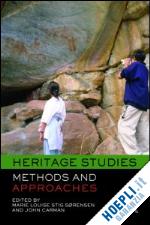Part 1: Setting the Scene 1. Introduction: Making the means transparent: reasons and reflections, Marie Louise Stig Sørensen and John Carman2. Heritage Studies – an outline, Marie Louise Stig Sørensen and John Carman3. Public Archaeology in United States in the early twenty-first century, Barbara Little Part 2: Heritage Methodologies: Investigating Texts4. The history of heritage: a method in analyzing legislative historiography, Hilary Soderland5. Means maketh the end – the context for the development of methodologies to assessing the state of the historic environment in the UK, Ian Baxter6. Methods used to investigate the use of the past in the formation of regional identities,Ulrike Sommer Part 3: Heritage Methodologies: Investigating People7. Reflections on the practice of ethnography within heritage tourism, Catherine Palmer8. Heritage Ethnography as a specialised craft: Grasping maritime heritage in Bermuda, Charlotte Andrews9. Between the lines and in the margins: interviewing people about attitudes to heritage and identity,Marie Louise Stig Sørensen10. Walking a fine line: obtaining sensitive information using a valid methodology, Morag Kersel11. Methods for investigating locals’ perceptions of a cultural heritage product for tourism: lessons from Botswana, Susan Keitumetse12. The public archaeology of African America: reflections on pragmatic methods and their results, Carol McDavid Part 4: Heritage Methodologies: Investigating Things13. The use of GIS in Landscape Heritage and Attitudes to Place- Digital Deep Maps, Matthew Fitzjohn14. Making them draw: the use of drawings in research into public attitudes towards the past, Grete Lillehammer15. The heritagescape: looking at heritage sites, Mary-Catherine Garden16. The intangible presence: investigating battlefields, John Carman and Patricia Carman Part 5: CommentariesCommentary: the view from social anthropology; Paola Filippucci. Commentary: the view from environmental psychology; David Uzzell











